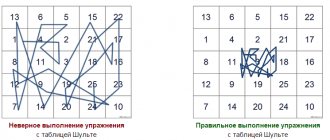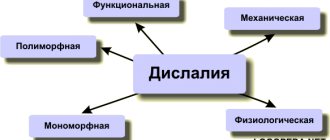24.09.2021
Dyslexia and dysgraphia are commonly understood as partial disorders of reading and writing processes. But in relation to children of primary school age, it is more correct to talk not about the disorder, but about the difficulties of mastering written language.
These difficulties usually manifest themselves in a complex and are expressed in the presence of persistent specific errors that cannot be explained by the level of intellectual development of the child, physiological pathologies of hearing or vision, or irregular schooling.
As a rule, reading and writing disorders are caused by a delay in the formation of certain functional systems that are necessary for the development of written speech. Also, some researchers (A. Luria, S. Lyapidevsky, S. Blinkov) note that dyslexia and dysgraphia occur with organic speech disorders. B. Hallgren and M. Roudinesco write in their works about a hereditary predisposition to dyslexia: qualitative immaturity of individual brain structures involved in the organization of written speech can be passed on from mother to child.
By the way, scientists wrote back in the 20s that dyslexia is inherited. last century. You can read about this in the first part of this material, which talks about the history of dyslexia research.
However, already in the mid-1990s. A larger number of studies have appeared, which prove that one of the causes of dyslexia and dysgraphia is functional asymmetry in the activity of paired sensorimotor organs. In other words, the child has not established the dominant role of one of the cerebral hemispheres (it should be noted that in order to successfully master the skills of reading and writing, the left hemisphere of the brain must dominate).
The lack of dominance of the left hemisphere of the brain leads to disorders not only of speech development, but also to problems of control over many other activities.
A significant number of children with reading and writing disorders have insufficient auditory-motor coordination, a sense of rhythm, and undeveloped voluntary motor skills.
It is important to note here that children with a clear dominance of one of the brain hemispheres, no matter whether the child is left-handed or right-handed, have the so-called. “strong points” (terminology proposed by N. Granjon and J. Ajuriaguerre), important for his constructive actions. Children with a lack of dominance of the cerebral hemisphere lose these “points”, as a result of which they experience difficulties with reading and writing.
It should be noted that all researchers are confident: every case where dyslexia and dysgraphia are combined with mental disability, hearing loss or vision loss requires careful diagnosis. And only after it can a specific diagnosis be made!
Affective disorders
These are mood disorders, that is, various disorders of the psycho-emotional state. Their connection with dyslexia was carefully studied by Aubry-Roudinesco, who even established a new pathogenetic type of dyslexia. Its peculiarity is that the leading ones are affective disorders.
And this is an absolutely correct statement, since affectivity (from affect - an emotional process of an explosive nature, which is characterized by short duration and high intensity) is one of the key drivers of the entire mental life of a child. Therefore, with dyslexia, it is extremely important to ensure a normal psycho-emotional state of the child, to create for him at least a calm atmosphere at home.
It should be remembered that dyslexic children are capable of “exploding” over any little thing. And any violation of their psycho-emotional state always negatively affects learning and, in particular, the development of reading and writing skills.
Impaired written speech in younger schoolchildren
Currently, the problems of studying, diagnosing and correcting written speech disorders in children are among the most pressing tasks of pedagogy and speech therapy. This article analyzes the main reasons for the manifestation of persistent specific errors in the written work of primary schoolchildren, provides a classification of dysgraphia, and also describes the directions of correctional work with children with these disorders.
The problem of written speech disorders in schoolchildren is one of the most pressing for school education. About 40% of children from the total number of primary school students have one or another type of written language disorder (dysgraphia). Therefore, the problem of providing assistance to children with writing disorders remains urgent. In this regard, the purpose of this article is to comprehensively analyze the main disorders of written speech in primary schoolchildren.
So, the process of mastering written speech is in close interaction with the degree of formation of all aspects of oral speech: sound pronunciation, phonemic perception, lexical and grammatical aspects of speech, coherent speech. It follows that the cause of dysgraphia can be the same functional and organic disorders that cause oral speech disorders.
Also in the development of dysgraphia, one can note socio-psychological factors, such as a deficit of speech contacts, inattention to the child’s speech on the part of adults, unjustifiably early learning to read and write in the absence of a child’s psychological readiness, which contribute to the occurrence of disorders in the development of written speech.
The key to successful mastery of writing lies in a sufficiently high level of development of oral speech. But it is worth noting that, unlike oral speech, written speech can only develop under the condition of systematic and targeted training [1, p. 7].
The main sign of dysgraphia is typical and repeated errors in writing of a persistent nature, not related to ignorance of the rules and norms of the language. Such errors include: mixing and replacing graphically similar handwritten letters (sh-sch, t-sh, v-d, m-l) or phonetically similar sounds (b-p, d-t, g-k, sh- and); distortion of the letter-syllabic structure of a word (omissions, rearrangements, addition of letters and syllables); violation of the unity and separateness of the spelling of words; agrammatisms in writing (violation of inflection and agreement of words in a sentence). Children with dysgraphia have a low writing speed, difficult to distinguish handwriting, fluctuations in the height and inclination of letters, slipping from the line, etc. The presence of dysgraphia is diagnosed at the age of 8–9 years [4, p. 131].
Classification of dysgraphia is carried out on the basis of various criteria: taking into account impaired analyzers, undeveloped writing operations, and mental functions. Thus, the following types are distinguished:
- Articulatory-acoustic. These disorders are due to the fact that children pronounce sounds incorrectly, which means that when they pronounce them to themselves, they write them down incorrectly. To treat this type of dysgraphia, it is necessary to work on the correct pronunciation of sounds.
- Acoustic. Here children pronounce sounds correctly, but confuse them with similar sounds (voiceless-voiced: b-p, d-t, z-s; hissing: s-sh, z-z; and are also unable to distinguish the softness of individual sounds).
- Optical. Children with optical dysgraphia have difficulty writing and distinguishing letters: they add extra elements (sticks, lines, circles), skip the necessary ones, and can write in a mirror image in the opposite direction).
- Dysgraphia due to problems of language analysis and synthesis. Children with such a problem in writing may skip or repeat entire words, rearrange syllables and letters, write different words together (confuse prefixes and prepositions of nouns, attach part of the next word to one word, etc.).
- Agrammatic dysgraphia. Such violations are detected after grades 1–2, as they require greater knowledge of the rules of spelling words. This problem is due to the fact that children cannot correctly inflect words by gender and case, and cannot agree on an adjective and a noun (“good dog”, “beautiful field”, etc.). This problem can be observed in bilingual (bilingual) families, as well as when a child is taught in a non-native language [2, p. 56].
Overcoming dysgraphia requires coordinated work of a neurologist, speech therapist, teacher, child and his parents. Impaired written speech will not disappear on its own; mandatory work is required to eliminate this defect. In order to improve a child’s written speech, it is necessary to diagnose and fill gaps in the pronunciation of sounds, phonemic perception, develop the grammatical aspect of speech and expand the child’s vocabulary.
Dysgraphia correction classes include:
− work on correct articulation and reproduction of sounds;
− phonemic hearing training;
− analysis of sounds, as well as work on understanding the sound-letter composition of a word;
− writing training includes regular dictations, searching for letters indicated by the teacher in the text, word games, memorizing the spelling of letters;
− exercises for fine motor skills and improvement of interhemispheric connections also occupy an important place [3, p. 135].
All speech therapy classes are built with mandatory consideration of the child’s psychological characteristics, his speech development and the type of manifestations of dysgraphia. In addition, it is important to develop in the student a positive attitude towards work and the psychological component of speech, to stimulate him to study and achieve results.
Of course, an important place is given to the prevention of violations. Prevention of dysgraphia must begin in preschool age. Preventive work should include the targeted development of higher mental processes, spatial concepts, auditory and visual differentiation, and graphomotor skills. Timely correction of oral speech disorders is of great importance.
So, writing disorders (dysgraphia) in children of primary school age have been studied for a long time, but even now it is one of the most pressing problems in pedagogy and speech therapy, because dysgraphia is one of the most common forms of speech pathology in primary schoolchildren. Writing disorders affect the entire learning process and speech development of children. Timely identification of these disorders and precise determination of their pathogenesis in each individual case is extremely important for the development of speech therapy work with children.
Literature:
- Dubynina T. E. Causes of dysgraphia in younger schoolchildren // Modern psychology and pedagogy: problems and solutions: collection. Art. by mother XVII international scientific-practical conf. No. 12(16). — Novosibirsk: SibAK, 2021. — pp. 7–10.
- Kornev A. N. Dyslexia and dysgraphia in children. — 3rd ed. - St. Petersburg: Hippocrates, 2012. - 224 p.
- Melyukhanova E. E. Correction of dysgraphia in younger schoolchildren // Innovative science. - 2021. - No. 5. - P. 132–137.
- Sadovnikova I. N. Impairments in written speech and their overcoming in primary schoolchildren. - M., 1997. – 300 p.
The mother-child connection
Why is the mother not just a spectator in the “Successful Start” dyslexia correction course, but actively involved in the correction process? This is explained by the fact that the course provides her with recommendations on harmonizing relationships in the family. She is the one who masters self-help skills for dyslexia and literally learns how to interact with her child again.
There is a scientific basis for this.
Thus, the research group of the Claparède Institute back in the early 1990s. It has been found that the basis of dyslexia is often a negative connection between mother and child. Their relationship is most often based on conflict. For example, a mother forcibly feeds her child, as a result he begins to resist her and gradually transfers this manner to other areas of life. And this manifests itself, first of all, in training. Moreover, the child uses the developed model of behavior in relations with the teacher, as a result of which pedagogical efforts do not have any result.
PREFACE
The problem of violations of written speech is revealed in theoretical and practical aspects. The author introduces readers to the reasons for the occurrence of these disorders in schoolchildren, and proposes an original system of work to overcome impairments in written speech, taking into account modern requirements for the content of school education.
For speech therapists, Russian language teachers, students of defectology faculties and primary education faculties of pedagogical universities.
The problem of impaired writing in schoolchildren is one of the most pressing for school education, since writing and reading from the purpose of primary education turn into a means of further acquisition of knowledge by students.
The book reflects the results of many years of scientific and practical activity of the author, developing the problem of writing and reading disorders in relation to the population of students in secondary schools and, mainly, primary classes, because the main task of a school speech therapist is to promptly identify and overcome disorders of written speech, preventing their transition, complicating the educational and cognitive activity of students, to subsequent stages of education.
The first section of the book covers the prerequisites for the formation of writing and reading normally and the mechanisms of disorders leading to persistent specific errors in written speech; The revealed typology of such errors is illustrated by examples from student works. An original system for identifying and recording specific writing errors by a speech therapist is presented. The criteria for distinguishing dysgraphia from immaturity of writing skills, characteristic of the stage of literacy acquisition, are described. Diagnostic tasks are proposed to identify dysgraphia in students in grades 1–3. Materials from a comprehensive study of schoolchildren with dysgraphia are presented, characterizing the state of a number of their sensorimotor and gnostic functions that are important for the development of written speech.
The second section reveals a system of correctional education to overcome written language disorders - in four main areas. Each chapter is preceded by the necessary methodological commentary, defining the tasks and methods of organizing the proposed types of work. The range of topics, content and forms of work are determined by the specifics of speech therapy tasks, but at the same time they correlate with the key issues of the Russian language program in primary school.
coordination
management
use of prepositions
Chapter III. STUDY OF CHILDREN WITH WRITTEN SPEECH DISORDERS
§1. STUDY OBJECTIVES
We conducted a speech examination of 1,924 primary school students in a comprehensive school in order to identify speech pathology. As a result, 542 students were found to have speech impairments (28%). An in-depth study of speech development was carried out in 365 of them. Of this number of speech pathologists, 155 (42.5%) had oral speech disorders. Impairments in written speech (in combination with impairments in sound pronunciation in some of them) were identified in 210 schoolchildren (57.5%). Of these latter they had:
§ writing disorders without problems with sound pronunciation - 96 people (45.7%);
§ writing disorders combined with phonetic disorders - 74 people (35.2%);
§ • writing disorders due to mental retardation - 22 people (10.5%);
§ writing disorders associated with affective imbalance and immaturity - 10 people (4.8%);
§ writing impairment due to mild hearing loss - 8 people (3.8%).
We conducted an experimental study of a group of schoolchildren suffering from writing impairments with normal intelligence, hearing, vision, and without severe affective disorders.
For many schoolchildren, the disorders we have considered go beyond the scope of grapho-lexical activity. In this regard, we included in the research program, in addition to the traditional examination of speech development, a number of gnostic-praxic functions, for which we used the method of studying higher cortical functions of a person with local brain lesions, developed by A. R. Luria, tests of N. I. Ozeretsky , Heda et al.
In addition to generalized data on each function we studied, we provide specific examples - excerpts from research protocols that allow us to understand the specifics of children’s worldview and the diversity of their individual characteristics.
The study aimed to find out: features of laterality and spatial orientation; temporary representations and concepts; motor functions of the hand; auditory-motor coordination; letter gnosis; phonemic development; sound analysis and synthesis; speech attention and memory; state of oral speech (sound pronunciation, vocabulary, grammatical structure); reading features; state of the letter.
§2. STATE OF LATERALITY AND SPATIAL ORIENTATION
Based on the material of a series of tests to identify the dominant arm, leg, and dominant eye in schoolchildren aged 7–10 years, the following was revealed:
§ clearly expressed lateralization can be seen in 40% of those examined, incl. right-sided - in 32%, left-sided - in 2%, crossed - in 6% of children in the experimental group;
§ In 60% of those examined, the test results indicate unformed laterality, i.e. The leader of the paired sensorimotor organs has not been determined, which indicates an unformed, protracted process of lateralization or left-handedness in the stage of relearning under the influence of family and school.
Let us illustrate cases of cross lateralization.
Pavlik Sh, 7 years old, 1st grade. The tasks in each series of tests were completed in the same way: with the right hand; left leg; left eye. He explains the diagram of his own body correctly, but uncertainly. The right and left directions in the initial position are indicated correctly, but when turning, the left direction is indicated with the left hand extended forward, the right - similarly - with the right hand, due to which both of these directions coincide in the meaning of “forward”. He determines the body diagram of the person standing opposite uncertainly, with errors. Heda performs the reflected actions in the test in a mirror manner.
Olya L, 8 years old, 2nd grade. The leading left hand and eye coincide, the leading leg is the right. He perceives the diagram of his own body erroneously: he considers the right parts of the body to be the left and vice versa. Similarly determines the right and left directions. He perceives the body diagram of the person standing opposite him in a mirror, thanks to which he gives formally correct answers. Performs reflected actions in a mirror manner.
Rudik Ch, 8 years old, 2nd grade. Leading hand is left, leading leg is right, leading eye is left. He perceives the diagram of his own body in a unique way: he identifies his arms correctly, although not quite confidently, and his legs crosswise (i.e., he considers his right arm and left leg to be right; left – his left arm and right leg), apparently in accordance with the execution friendly actions when walking. It also cross-determines the diagram of the body standing opposite. The remaining parts of the body (ear, cheek, shoulder) are correlated with the hand and identified correctly. Find it the same way! right and left directions.








